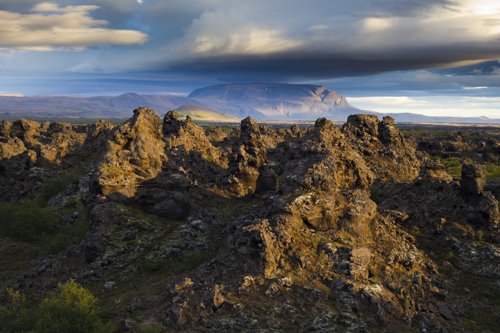Vinna við nýjar heimasíður Umhverfis- og orkustofnunar og Náttúruverndarstofnunar er í gangi. Heimasíða Umhverfisstofnunar er virk á meðan vinnunni stendur. Information in English
Dimmuborgir

Dimmuborgir is protected due to its unique lava formations and landscape.
Lava formations such as those in Dimmuborgir have not been found anywhere outside Lake Myvatn Nature Conservation area except at the bottom of the ocean off the coast of Mexico. Similar lava formations can be found elsewhere by Lake Myvatn. The lava rock stacks by Höfði (Klasar and Kálfandarstrípar) are the best known of these.
The aim of the protection of Dimmuborgir as a natural monument is to preserve distinctive geological formations. Furthermore, the aim of the protection is to preserve the geological formations in the area due to their high educational value and value for outdoor activities, as the whole area has long been a popular outdoor activity spot for the locals and a destination for tourists travelling around the Lake Myvatn Conservation area.
Where Is the Natural Monument?
Dimmuborgir is located by Lake Myvatn in north-east Iceland. It is about 1 km east of the Geiteyjarströnd farms. The protected area is approx. 423 hectares in size. The following links contain information in Icelandic.
- Management and protection plan for Dimmuborgir
- Advertisement for the natural monument Dimmuborgir in Skútustaðahreppur
- Map
- Agreement on the management and operation of the Dimmuborgir natural monument in Skútustaðahreppur
Points of Interest
Dimmuborgir is composed of unique lava formations, the remains of an emptied lava lake formed approx. 2300 years ago when lava flowed from Lúdents- and Þrengslaborgir over Mývatn and through Aðaldalur out to sea. A blockage in the lava where Dimmuborgir formed caused molten lava to pool underneath a solidified lava crust, forming a circular depression, or lava lake, around 2 km in diameter and 20 m high. The molten lava then moved west towards Mývatn, leaving behind lava stacks, or chimneys in incredible formations. It is thought that the chimneys formed in the lava lake where steam rose up through the molten lava, cooling it. In many places, there are signs that the lake's half-solidified crust smeared the stacks with molten lava when it subsided as the lake emptied.
Dimmuborgir has been managed by the Soil Conservation Service of Iceland since 1942, when the landowners of the farms Geiteyjarströnd and Kálfaströnd donated it to the Sand Reclamation Service (now Soil Conservation Service) because they realized they wouldn't be able to protect the lava formations from sand that was blowing into them and smothering them. The Soil Conservation Service of Iceland has carried out extensive, successful land reclamation work in the area. The Soil Conservation Service has also been responsible for the development of the area as a tourist destination in collaboration with the Environment Agency of Iceland.
Dimmuborgir comes to life in the lead-up to Christmas, when the Dimmuborgir Yule Lads make an appearance.
Access
A paved road leads to Dimmuborgir from Geiteyjarströnd.
Snow, ice and slush ponds can limit and even prevent walking around Dimmuborgir.
A service building by the parking area in Dimmuborgir has toilet facilities, food and a souvenir shop.
- Dimmuborgir was protected as a natural monument in summer 2011.
- Disturbing, or in any way damaging, the geological formations and cultural heritage of the area is prohibited, as is damaging vegetation or intentionally disturbing wildlife within the natural monument boundaries.
- Follow marked trails in accordance with the supervisor’s instructions.
- Camping in the area is prohibited, as is burying or discarding garbage within the natural monument.
- Dogs are prohibited in the natural monument unless with a special permit from the supervisor.